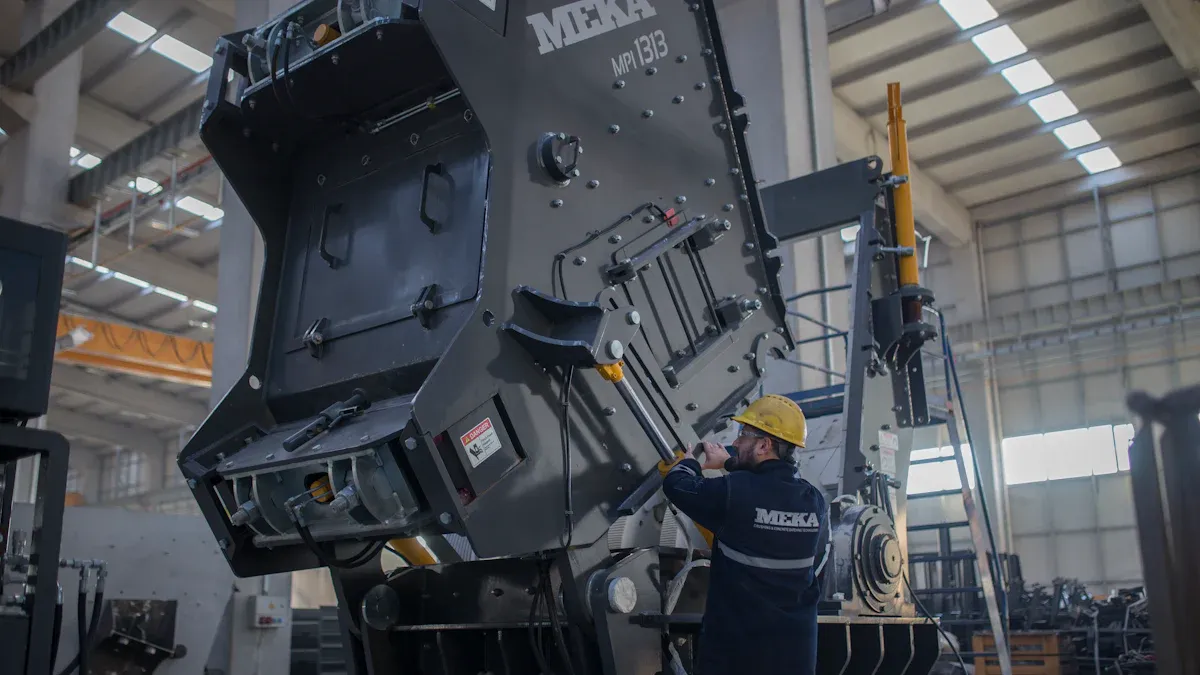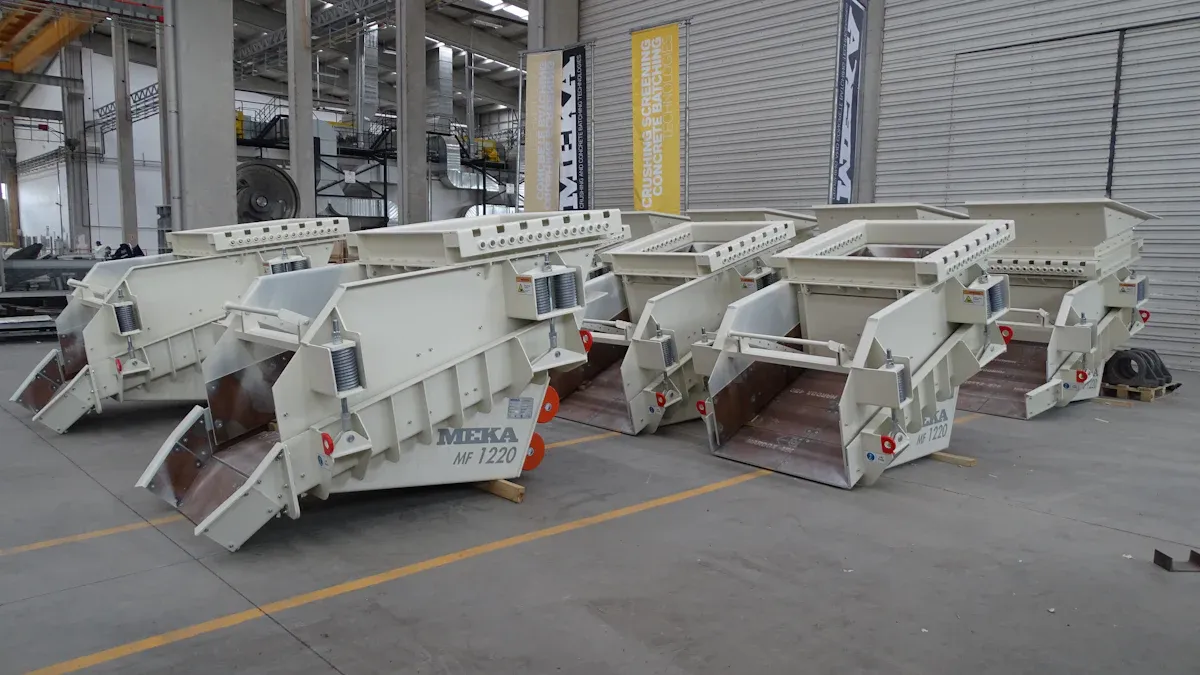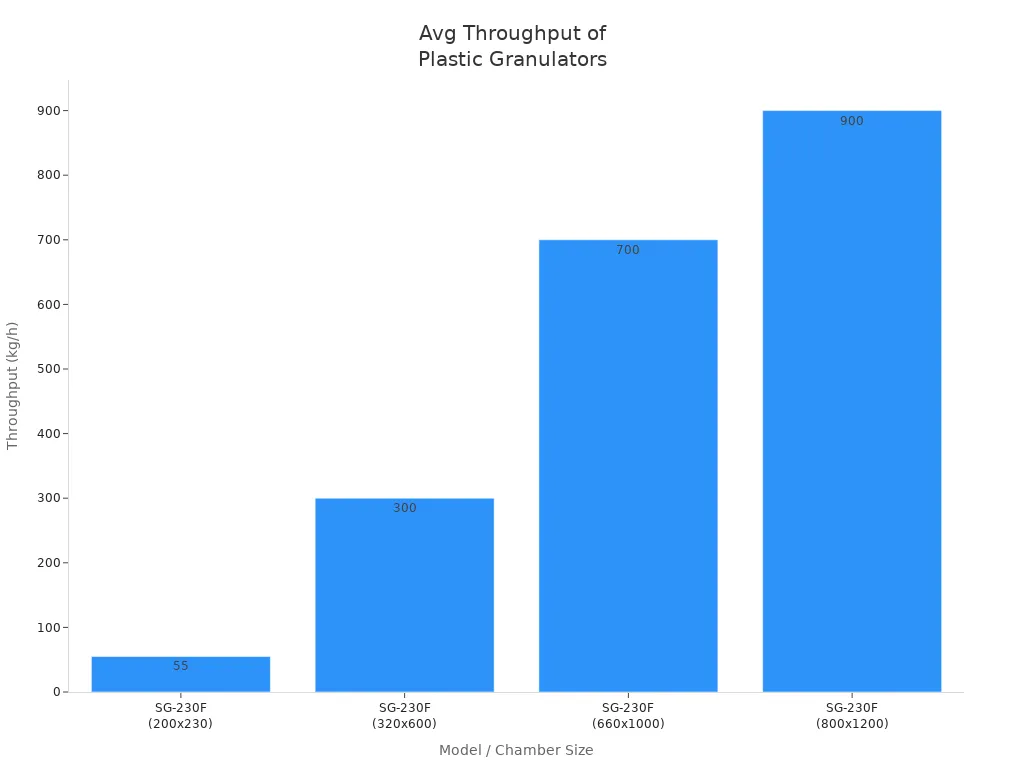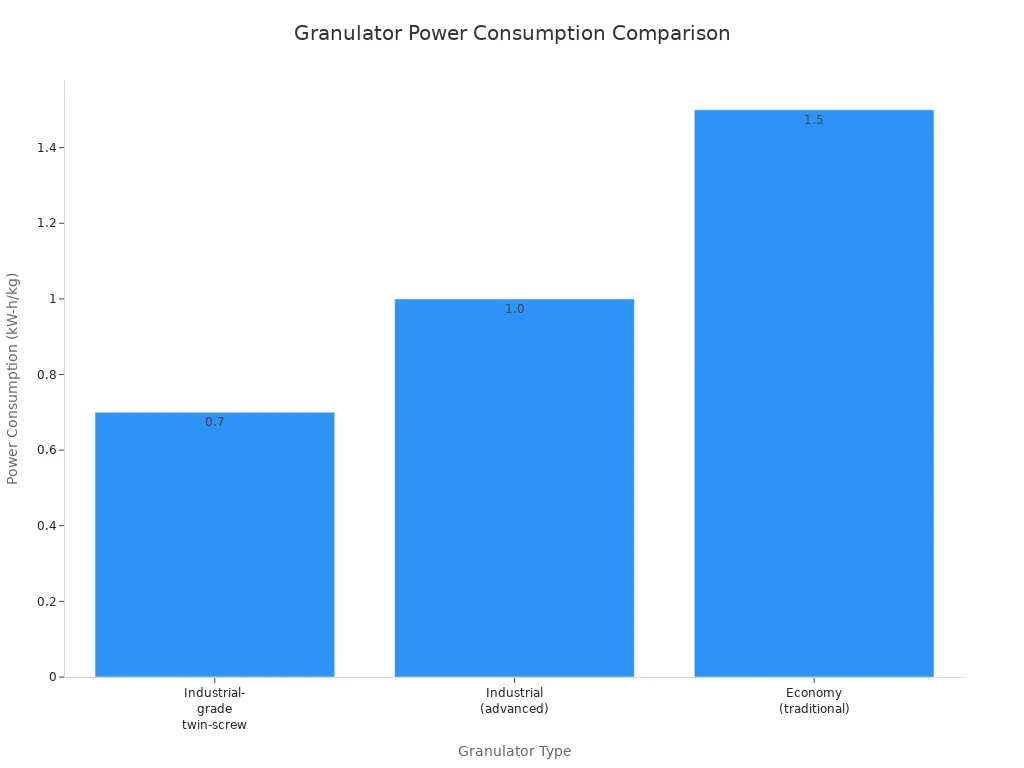
A plastic granulator plays a crucial role in both recycling and injection molding facilities. Operators value machines that produce uniform granules, as this consistency boosts recycling efficiency and supports smooth production. Advanced granulator machines handle many types of plastics, offering flexibility for different projects. Energy-saving features in these machines help lower operational costs. Some models, like a granule plastic machine or a plastic crusher, also reduce waste by optimizing material use. These qualities support sustainability and reliable performance in modern plastic processing environments.
Key Takeaways
- Plastic granulators must produce uniform granules to ensure consistent product quality and efficient recycling or molding.
- Choosing the right granulator depends on the type of plastic, processing volume, and application needs like recycling or injection molding.
- Advanced granulators offer energy-saving features, noise reduction, and easy maintenance to lower costs and improve workplace safety.
- Strong safety features, including emergency stops and interlocks, protect operators and help meet industry standards.
- Reliable after-sales support and regular maintenance extend machine life and keep production running smoothly.
Plastic Granulator Application Needs

Recycling vs. Injection Molding Requirements
Recycling and injection molding each place unique demands on a plastic granulator. In injection molding, operators often use smaller, high-performance granulators beside the molding machine. These machines handle sprues, runners, and defective parts. They focus on compactness and efficient processing of low-volume scrap. For example, a granulator used for PVC injection molding must break down tough, rigid materials into reusable granules. In contrast, recycling applications require larger, more robust granulators or shredders. These machines process bulky waste like bottles, pipes, and sheets. They need higher capacity and durability to handle a wide range of plastic types and sizes. The difference in scale and scrap type shapes the design and operation of each granulator.
Shared Demands for Both Applications
Both recycling and injection molding rely on certain key features in a plastic granulator. Operators look for machines that produce uniform granule sizes, which helps maintain consistent product quality. Safety remains a top priority, so features like emergency stop buttons and safety interlocks are essential. Easy access to blades and screens allows for quick maintenance and cleaning. Many facilities prefer granulators with low noise levels and mobile designs for flexible placement. The table below highlights some shared operational features:
| Feature | Benefit |
|---|---|
| Uniform granule size | Consistent product quality |
| Safety interlocks | Operator protection |
| Easy maintenance | Reduced downtime |
| Low noise operation | Improved work environment |
| Portability | Flexible use in different locations |
Evaluating Material Types and Processing Volumes
Facilities process many types of plastics, including sprues, shells, tubes, bottles, and films. Some plastics, like those with high glass fiber content, require special granulators with durable surfaces and high-torque grinding. The choice of granulator also depends on processing volume. Small-scale operations use compact models for light materials, while large recycling centers need industrial machines that handle several tons daily. Selecting the right granulator ensures efficient processing and prevents bottlenecks, whether the goal is in-house recycling or large-scale waste reduction.
Plastic Granulator Essential Features

Material Compatibility and Versatility
A plastic granulator must handle a wide range of materials to serve both recycling and injection molding applications. Operators often process items such as blow-molded bottles, electrical connectors, screw pieces, and extruded profiles. Machines with multiple base models, like FX 700, FX 1000, and FX 1600, allow users to match the granulator to different part sizes and throughput needs. Flexible chamber configurations, such as tangential chambers for large parts and offset chambers for thick-walled components, increase adaptability.
Note: Customizable hoppers and discharge designs help fit the granulator into various system layouts, making it easier to integrate with existing equipment.
Versatility also depends on the ability to process plastics with different additives or hardness levels. Granulators with wear-resistant surfaces and easy maintenance access reduce downtime and extend equipment life. Enhanced safety features, including redundant interlocks and solenoid-activated locks, protect operators during use. Sound suppression designs lower noise, improving the work environment. Models like the SL and G26 series stand out for their broad material compatibility, supporting both recycling and injection molding processes.
Throughput Capacity and Efficiency
Throughput capacity measures how much material a plastic granulator can process in a given time. Facilities choose machines based on their daily processing needs. Small chambers suit low-volume operations, while large chambers handle bulk recycling. The table below shows typical throughput capacities for different models:
| Model / Chamber Size (mm) | Throughput Capacity (kg/h) | Motor Power (kW) | Notes |
|---|---|---|---|
| SG-230F (200×230) | 50 – 60 | 4 – 45 | Small chamber, lower capacity |
| SG-230F (320×600) | 250 – 350 | 4 – 45 | Medium chamber |
| SG-230F (660×1000) | 600 – 800 | 4 – 45 | Larger chamber |
| SG-230F (800×1200) | 800 – 1,000 | 4 – 45 | Largest chamber, high output |

Advanced features improve efficiency and product quality. Adjustable rotating knives maintain a constant cutting circle after sharpening, which extends knife life and ensures high-quality regrind. Staggered rotor designs reduce power spikes and energy use, especially when processing thick parts. Open-rotor designs enhance airflow and cooling, which is important for delicate materials. Intelligent feeding systems and optimized screw and barrel designs further increase output and pellet quality. Energy-efficient granulators with variable frequency motors can save thousands of dollars in electricity costs each year.
Particle Size Control and Uniformity
Consistent particle size is vital for both recycling and injection molding. Adjustable screen mesh sizes allow operators to control granule size and uniformity. High-speed rotors shear plastics into small, even fragments. Dust extraction systems remove fines, and magnetic separators catch metal contaminants, ensuring clean output. Smart sensors and control panels monitor and adjust rotor speeds in real time, keeping particle size consistent.
Modern plastic granulators use customizable screen sizes and adjustable rotor speeds to produce uniform granules. This uniformity supports predictable flow and spreadability in injection molding, leading to consistent product quality. In recycling, uniform particles improve washing, melting, and pelletizing efficiency. Equipment like vertical color mixers ensures over 95% uniformity, reducing defects and improving mechanical performance.
Tip: Regular maintenance and smart sensors help detect issues early, preventing inconsistent particle size and reducing downtime.
Uniform particle size also allows for better mixing, color consistency, and mechanical strength in finished products. Machines that offer quick setting changes and automation adapt easily to different product requirements, enhancing versatility and supporting high-quality results in both recycling and injection molding.
Cutting Technology and Blade Design
Cutting technology forms the core of every plastic granulator. The right blade design ensures efficient processing, high-quality granules, and minimal downtime. Modern granulators use several advanced features to meet the needs of both recycling and injection molding applications.
- V-cut rotor knives create high-quality regrind with fewer fines, which improves the consistency of the output.
- Multiple rows of rotor knives, such as 9, 11, or 13 rows, boost cutting capacity and allow the machine to handle larger volumes.
- Removable deflector wedges act as a third stator blade. This feature increases cutting aggressiveness and allows for quick adjustments during operation.
- Oversized rotor bearings and knife mounts support heavy-duty recycling tasks. These parts resist wear and extend the life of the granulator.
- Wear-resistant steels and hard-facing on rotors and housings protect the machine from abrasive or contaminated materials.
- Strong welded steel construction ensures durability, even in demanding environments.
- Heavy-duty outboard bearings, separated from the cutting chamber, prevent contamination and reduce the risk of premature failure.
Blade design also affects maintenance and granule quality. Dull or poorly spaced blades can cause non-uniform, dusty granules and lower throughput. Adjustable rotating blades allow for individual sharpening, which extends blade life and keeps granule size consistent. Regular inspection and preventive maintenance, such as sharpening and gap adjustment, help minimize downtime.
| Aspect | Evidence Summary |
|---|---|
| Blade Materials | Tungsten carbide and high-speed steel blades offer high wear resistance and longer service life, reducing maintenance frequency. |
| Blade Gap | Proper blade gap (0.1-0.3 mm) is critical for cutting efficiency; incorrect gap causes dull blades, uneven granules, and increased maintenance. |
| Blade Design | Spiral knife design improves cutting efficiency and reduces clogging, enhancing granule quality. |
| Maintenance Practices | Regular cleaning, lubrication, and dynamic balance calibration extend blade life and maintain granule uniformity. |
| Impact of Poor Design | Poor blade condition leads to dusty, non-uniform granules and more frequent maintenance needs. |
A plastic granulator with advanced cutting technology and well-designed blades delivers reliable performance, high-quality granules, and lower maintenance costs.
Energy Efficiency and Noise Reduction
Energy efficiency has become a top priority in modern manufacturing. Advanced plastic granulators use energy-efficient motors and intelligent temperature control systems to reduce power consumption. Industrial-grade twin-screw models can use up to 40% less energy than traditional economy models. This improvement lowers operating costs and supports sustainability goals.

Noise reduction is another important factor in the workplace. Plastic granulators can be noisy, but manufacturers now offer soundproof models and noise-reducing designs. Soundproof casings and fully automatic controls help lower noise levels, making the work environment safer and more comfortable. These features also help facilities meet environmental noise regulations and improve overall operational efficiency.
Tip: Using ear protection and maintaining soundproof barriers around the granulator can further reduce noise exposure for operators.
Modern plastic granulators combine energy-saving features with noise reduction technologies to create a safer, more efficient, and environmentally friendly workspace.
Safety Features and Compliance
Safety remains a critical concern in any facility using a plastic granulator. Machines must meet strict safety standards to protect operators and ensure reliable operation.
- ANSI/PLASTICS B151.11-2021 outlines safety requirements for granulators, covering design, operation, maintenance, and modification.
- Other relevant standards include ANSI/PLASTICS B151.1-2017 for injection molding machines and ANSI/PLASTICS B151.27-2021 for robot/injection molding machine systems.
- Compliance with these standards is essential for safe operation in major manufacturing markets.
Plastic granulators require several built-in safety controls:
- Lock-out/tag-out systems disconnect power before maintenance or cleaning.
- Guards and interlocks prevent access to moving knives.
- Emergency stop buttons, obstruction alarms, and dual electrical safeties provide immediate response to hazards.
- Operators must wear personal protective equipment, such as gloves, eye, face, ear, and dust protection.
- Regular inspections and daily safety checks keep the machine in safe working order.
- Operators need proper training and clear instructions in a language they understand.
Note: Keeping the work area clean and free of obstacles helps prevent slips, trips, and other accidents.
By following these safety practices and complying with recognized standards, facilities can ensure safe and efficient operation of their plastic granulators.
Plastic Granulator Operational Considerations
Feeding Methods and Loading Options
Operators can choose from several feeding methods when integrating a plastic granulator into a production line. Manual feeding works well for small batches or occasional use. Conveyor feeding supports continuous operation and reduces manual labor. Roll feeding is ideal for thin plastic sheets or films. Robot feeding increases automation and safety by minimizing human contact with moving parts. Each method affects efficiency and material flow in different ways.
Placing granulators beside the press saves floor space and streamlines workflow. Front access panels make operation and maintenance easier. Automated feeding options also reduce manual handling, which lowers the risk of injury and improves production speed.
The table below highlights key operational factors to consider when selecting feeding and loading options:
| Operational Factor | Description & Considerations |
|---|---|
| Type of Plastic Material | Hard plastics need strong blades and motors; soft plastics require gentle handling. |
| Output Size Requirements | Adjustable screens help achieve the desired granule size for downstream processes. |
| Production Capacity | Throughput must match production needs to avoid bottlenecks. |
| Integration Compatibility | Feeding systems should connect smoothly with conveyors, robots, or other automation equipment. |
Maintenance and Cleaning Ease
Regular maintenance keeps a plastic granulator running smoothly and extends its lifespan. Operators should perform daily checks for loose bolts, leaks, or unusual noises. Clearing the hopper and inspecting the cutting chamber after each shift prevents material buildup. Weekly tasks include checking knives for dullness, cleaning screens, and lubricating bearings. Monthly deep cleaning and knife gap adjustments help maintain cutting efficiency.
- Daily: Inspect for damage, clear obstructions, and check safety features.
- Weekly: Examine knives and screens, lubricate bearings, and tighten fasteners.
- Monthly: Deep clean chambers, adjust knife gaps, and inspect electrical connections.
- Semi-Annual/Annual: Sharpen or replace knives, replace worn parts, and conduct a full inspection.
Using original equipment manufacturer (OEM) parts and following strict safety procedures ensures quality and operator safety. Keeping the work area clean also supports efficient maintenance.
Durability and Build Quality
Durability plays a key role in the long-term value of a plastic granulator. Machines built with heat-treated steel blades and robust motors withstand heavy use and abrasive materials. Modular construction allows for quick part replacement, reducing downtime. Easy-access designs make blade changes and cleaning faster, which helps maintain sharpness and efficiency.
High build quality can extend the lifespan of a granulator to 10-20 years. Regular inspections, proper lubrication, and timely replacement of worn parts keep the machine reliable. Strong frames and quality components lower operational costs and reduce the need for frequent repairs.
Investing in a durable granulator supports continuous production and helps facilities achieve long-term cost savings.
After-Sales Support and Spare Parts
After-sales support plays a vital role in the long-term success of any plastic processing operation. Companies in the recycling and injection molding industries rely on dependable service to keep their equipment running smoothly. When a machine stops working, production can halt, leading to lost time and money. Reliable after-sales support helps prevent these problems and ensures quick recovery when issues arise.
Many users value several types of after-sales services. These include:
- Access to experienced field service professionals who can diagnose and fix problems on-site.
- Application expertise that helps operators get the most out of their machines.
- Unwavering support from the supplier, which builds trust and confidence.
Recycling facilities often face unique challenges. They benefit from:
- Expert consultation tailored to their specific recycling processes.
- Comprehensive training for staff to operate and maintain equipment safely.
- Ongoing technical assistance to solve unexpected issues.
Injection molding users also look for:
- Professional installation to ensure machines work correctly from the start.
- Thorough training for all personnel.
- Reliable technical assistance and a steady supply of spare parts.
- Maintenance services that help extend the life of the equipment.
Accessible support resources make a difference. Many companies offer:
- Consultation services to answer questions and provide guidance.
- Video support for troubleshooting and repairs.
- FAQs that help users solve common problems quickly.
Tip: Keeping a stock of essential spare parts on-site can reduce downtime and keep production moving.
A strong after-sales support system ensures that machines stay reliable and efficient. It also gives operators the confidence to handle daily challenges and plan for future growth.
Selecting the Right Plastic Granulator
Matching Granulator Types to Materials and Processes
Choosing the right granulator starts with understanding the materials and processes in use. Some facilities process hard plastics like ABS or polycarbonate. Others handle softer materials such as polyethylene film. Each material type needs a specific cutting chamber and blade design. For example, thick-walled parts require a tangential chamber, while thin films work best with open rotors. Operators should also consider the size of the scrap and the required output size. High-volume recycling centers may need large, heavy-duty models. Injection molding shops often prefer compact, beside-the-press units. Matching the granulator type to the material and process ensures efficient operation and high-quality results.
Balancing Cost, Value, and Long-Term Performance
Cost plays a big role in equipment selection. However, the lowest price does not always mean the best value. Facilities should look at the total cost of ownership. This includes energy use, maintenance, and spare parts availability. Machines with energy-efficient motors and durable blades often save money over time. Reliable after-sales support can reduce downtime and repair costs. Investing in a high-quality granulator helps maintain consistent production and reduces long-term expenses.
Tip: Consider the expected lifespan and maintenance needs before making a purchase. A well-built machine can last many years with proper care.
Granulator Selection Checklist
Operators can use a checklist to guide their decision:
- Identify the types and sizes of plastic materials to process.
- Estimate daily or weekly processing volumes.
- Check compatibility with existing feeding and discharge systems.
- Review safety features and compliance with industry standards.
- Evaluate energy efficiency and noise levels.
- Assess ease of maintenance and cleaning.
- Confirm availability of spare parts and technical support.
- Compare total cost of ownership, not just purchase price.
A careful review of these factors helps ensure the selected plastic granulator meets both current and future needs.
Selecting the right equipment ensures smooth operations in both recycling and injection molding. Facilities benefit from machines that offer cost efficiency, support environmental goals, and improve production speed. Key advantages include:
- Lower raw material costs through recycling.
- Reduced plastic waste for a cleaner environment.
- Easier handling and storage of granulated material.
- Consistent product quality with uniform granules.
- Simple maintenance and safer, cleaner workspaces.
Operators should use the checklist to guide their decision and achieve long-term success.
FAQ
What types of plastics can a granulator process?
Most plastic granulators handle common materials like ABS, PP, PE, PVC, and PET. Some models also process engineering plastics or materials with glass fiber. Always check the machine’s specifications for compatibility.
How often should operators perform maintenance on a granulator?
Operators should inspect the granulator daily for wear or damage. Weekly cleaning and lubrication help maintain performance. Monthly deep cleaning and blade checks extend machine life and ensure safe operation.
Why is uniform particle size important in plastic granulation?
Uniform particle size ensures smooth feeding in injection molding machines. It also improves melting and mixing during recycling. Consistent granules help maintain product quality and reduce waste.
Can a plastic granulator reduce energy costs?
Yes. Energy-efficient granulators use advanced motors and smart controls. These features lower electricity use and reduce operating expenses over time.
What safety features should a plastic granulator include?
A quality granulator includes emergency stop buttons, safety interlocks, and lock-out/tag-out systems. These features protect operators and help facilities meet industry safety standards.
Post time: Jul-17-2025